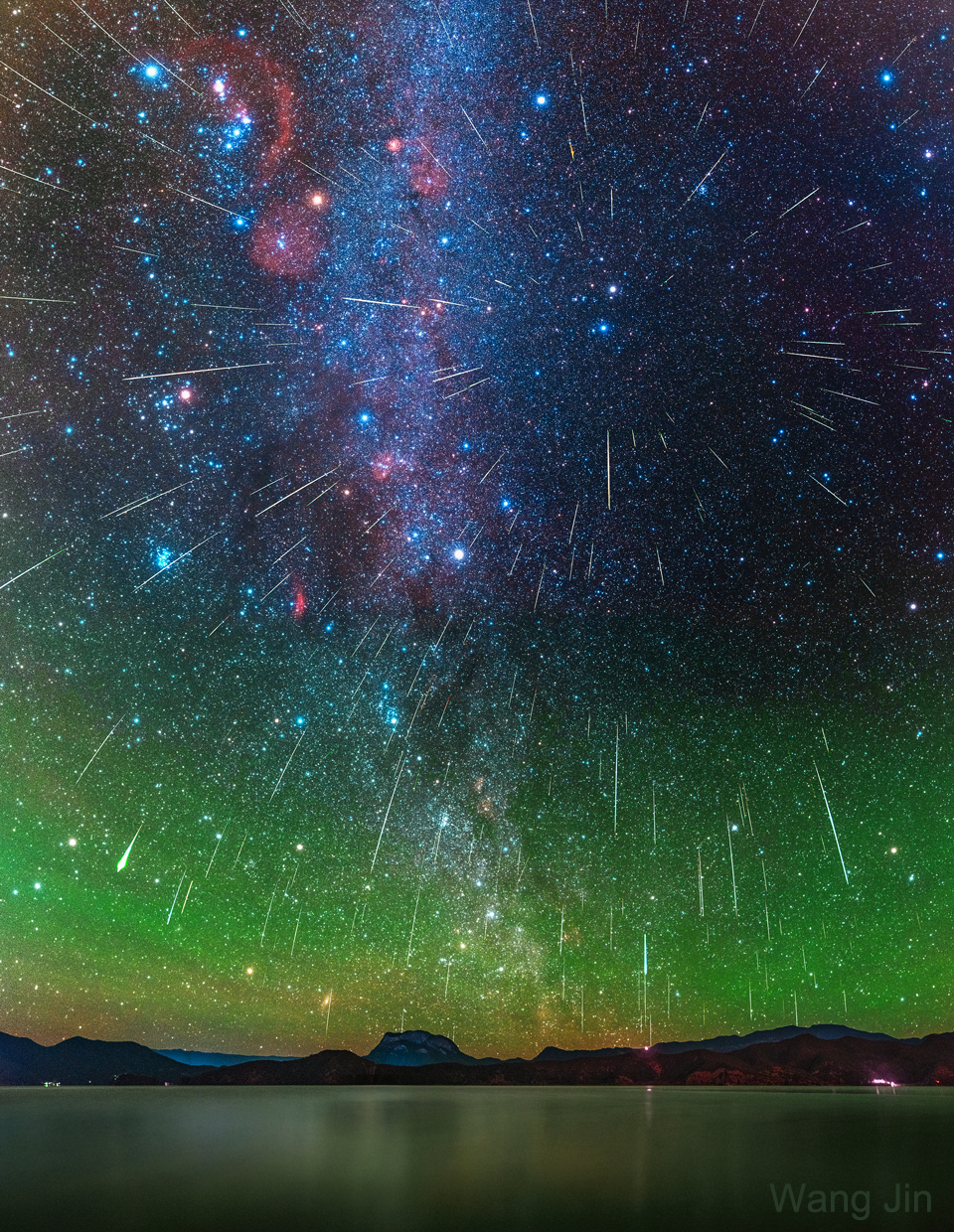16. November 2021
雙生仔座 ê 雙生仔流星雨

探索宇宙1!逐工會揀一幅無仝款 ê 影像抑是相片,𤆬你熟似咱這个迷人 ê 宇宙,閣有專業天文學者2為你3解說4。
- 原始文章:Geminids from Gemini
- 影像來源 kah 版權:Wang Jin
- 台文翻譯:An-Li Tsai (NCU)
[漢羅] 雙生仔座 ê 雙生仔流星雨
這寡流星是 ùi 佗位來 ê? 按照天頂 ê 方位來看,應該是 ùi 雙生仔 座 來 ê。 這就是是按怎 12 月 ê 流星會叫做 雙生仔座流星雨。 因為流星雨攏是 ùi 仝一个輻射點來 ê,這个 輻射點 tī 雙生仔座 內底。 毋閣 ùi 立體 ê 角度來看,這个無四常 ê 小行星 Phaethon 3200 噴出來 ê 沙塗粒,攏踅太陽 ê 軌道 leh 行。 伊倚地球彼爿軌道拄仔好疊 tī 雙生仔座 ê 頭前。 所以地球若是 行到這个軌道,流星屑仔 ê 輻射點 to̍h 會出現 tī 雙生仔座。 這張相片是 2020 年 12 月 14 這暗翕 ê 雙生仔座流星雨。 是 kā 200 外粒 足光 ê 流星 tī 天頂 行過 ê 光巡 疊做伙 ê。 11 月上重要 ê 流星 雨是 獅仔座流星雨,下暗 kah 明仔暗會上濟。 是講真不幸,今年 ê 流星會較暗,因為伊 上濟 ê 時陣是 tī 透早,而且閣拄著膨月,按呢會較歹 看著。 毋閣,每一點鐘應該攏會看著幾若粒 較光 ê 獅仔座流星。
[POJ] Siang-siⁿ-á-chō ê Siang-siⁿ-á liû-chhiⁿ-hō͘
Chit-kóa liû-chhiⁿ sī ùi tó-ūi lâi ê? Àn-chiàu thiⁿ-téng ê hông-úi lâi-khòaⁿ, eng-kai sī ùi Siang-siⁿ-á-chō lâi ê. Che tō-sī sī-án-ná cha̍p-jī goe̍h ê liû-chhiⁿ ē kiò-chò Siang-siⁿ-á liû-chhiⁿ-hō͘. In-ūi liû-chhiⁿ-hō͘ lóng-sī ùi kâng-chi̍t-ê hok-siā-tiám lâi ê, chit-ê hok-siā-tiám tī Siang-siⁿ-á-chō lāi-té. M̄-koh ùi li̍p-thé ê kak-tō͘ lâi-khòaⁿ, chit-ê bô sù-siông ê sió-kiâⁿ-chhiⁿ Phaethon saⁿ-chheng-jī phùn--chhut-lâi ê soa-thô͘-lia̍p, lóng se̍h Thài-iông ê kúi-tō leh kiâⁿ. I óa Tē-kiû hit-pêng kúi-tō tú-á-hó tha̍h tī Siang-siⁿ-á-chō ê thâu-chêng. Só͘-í Tē-kiû nā-sī kiâⁿ kàu chit-ê kúi-tō, liû-chhiⁿ-sap-á ê hok-siā-tiám to̍h ē chhut-hiān tī Siang-siⁿ-á-chō. Chit-tiuⁿ siòng-phìⁿ sī jī-khòng-jī-khòng nî cha̍p-jī goe̍h cha̍p-sì chi̍t-àm hip ê Siang-siⁿ-á-chō liû-chhiⁿ-hō͘. Sī kā nn̄g-pah-gōa-lia̍p chiok-kng ê liû-chhiⁿ tī thiⁿ-téng kiâⁿ-kòe ê kng-sûn tha̍h chò-hóe ê. Cha̍p-it goe̍h siōng tiōng-iàu ê liû-chhiⁿ-hō͘ sī Sai-á-chō liû-chhiⁿ-hō͘, e-àm kah miâ-á-àm ē siōng-chōe. Sī-kóng chin-put-hēng, kin-nî ê liû-chhiⁿ ē khah-àm, in-ūi i siōng-chōe ê sî-chūn sī tī thàu-chá, jī-cha̍p koh tú-tio̍h phòng-goe̍h, án-ne ē khah phái khòaⁿ-tio̍h. M̄-koh, múi chi̍t-tiám-cheng eng-kai lóng ē khòaⁿ-tio̍h kúi-ā-lia̍p khah-kng ê Sai-á-chō liû-chhiⁿ.
[KIP] Siang-sinn-á-tsō ê Siang-sinn-á liû-tshinn-hōo
Tsit-kuá liû-tshinn sī uì tó-uī lâi ê? Àn-tsiàu thinn-tíng ê hông-uí lâi-khuànn, ing-kai sī uì Siang-sinn-á-tsō lâi ê. Tse tō-sī sī-án-ná tsa̍p-jī gue̍h ê liû-tshinn ē kiò-tsò Siang-sinn-á liû-tshinn-hōo. In-uī liû-tshinn-hōo lóng-sī uì kâng-tsi̍t-ê hok-siā-tiám lâi ê, tsit-ê hok-siā-tiám tī Siang-sinn-á-tsō lāi-té. M̄-koh uì li̍p-thé ê kak-tōo lâi-khuànn, tsit-ê bô sù-siông ê sió-kiânn-tshinn Phaethon sann-tshing-jī phùn--tshut-lâi ê sua-thôo-lia̍p, lóng se̍h Thài-iông ê kuí-tō leh kiânn. I uá Tē-kiû hit-pîng kuí-tō tú-á-hó tha̍h tī Siang-sinn-á-tsō ê thâu-tsîng. Sóo-í Tē-kiû nā-sī kiânn kàu tsit-ê kuí-tō, liû-tshinn-sap-á ê hok-siā-tiám to̍h ē tshut-hiān tī Siang-sinn-á-tsō. Tsit-tiunn siòng-phìnn sī jī-khòng-jī-khòng nî tsa̍p-jī gue̍h tsa̍p-sì tsi̍t-àm hip ê Siang-sinn-á-tsō liû-tshinn-hōo. Sī kā nn̄g-pah-guā-lia̍p tsiok-kng ê liû-tshinn tī thinn-tíng kiânn-kuè ê kng-sûn tha̍h tsò-hué ê. Tsa̍p-it gue̍h siōng tiōng-iàu ê liû-tshinn-hōo sī Sai-á-tsō liû-tshinn-hōo, e-àm kah miâ-á-àm ē siōng-tsuē. Sī-kóng tsin-put-hīng, kin-nî ê liû-tshinn ē khah-àm, in-uī i siōng-tsuē ê sî-tsūn sī tī thàu-tsá, jī-tsa̍p koh tú-tio̍h phòng-gue̍h, án-ne ē khah phái khuànn-tio̍h. M̄-koh, muí tsi̍t-tiám-tsing ing-kai lóng ē khuànn-tio̍h kuí-ā-lia̍p khah-kng ê Sai-á-tsō liû-tshinn.
[English] Geminids from Gemini
Where are all of these meteors coming from? In terms of direction on the sky, the pointed answer is the constellation of Gemini. That is why the major meteor shower in December is known as the Geminids -- because shower meteors all appear to come from a radiant toward Gemini. Three dimensionally, however, sand-sized debris expelled from the unusual asteroid 3200 Phaethon follows a well-defined orbit about our Sun, and the part of the orbit that approaches Earth is superposed in front of the constellation of Gemini. Therefore, when Earth crosses this orbit, the radiant point of falling debris appears in Gemini. Featured here, a composite of many images taken during the 2020 Geminids meteor shower shows over 200 bright meteors that streaked through the sky during the night December 14. The best meteor shower in November, the Leonids, peaks tonight and tomorrow. Unfortunately, this year, dim meteors during the early-morning peak will be hard to see against a sky lit by a bright gibbous moon. Still, a few bright Leonid meteors should be visible each hour.
詞彙學習
| 漢羅 | POJ | KIP | 華語 | English |
|---|---|---|---|---|
| 雙生仔座 | Siang-siⁿ-á-chō | Siang-sinn-á-tsō | 雙子座 | Gemini |
| 輻射點 | hok-siā-tiám | hok-siā-tiám | 輻射點 | radiant point |
| 膨月 | phòng-goe̍h | phòng-gue̍h | 凸月 | gibbous moon |
| 雙生仔座流星雨 | Siang-siⁿ-á-chō liû-chhiⁿ-hō͘ | Siang-sinn-á-tsō liû-tshinn-hōo | 雙子座流星雨 | Geminids |
| 獅仔座流星雨 | Sai-á-chō liû-chhiⁿ-hō͘ | Sai-á-tsō liû-tshinn-hōo | 獅子座流星雨 | Leonids |